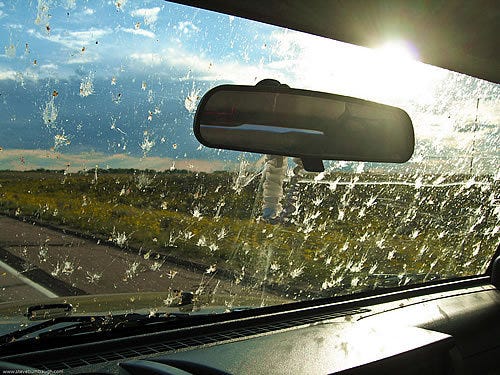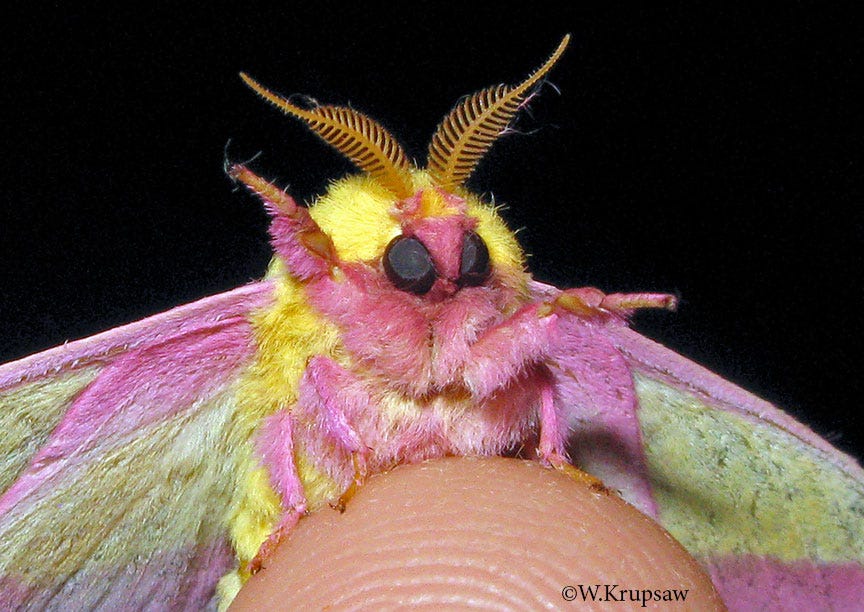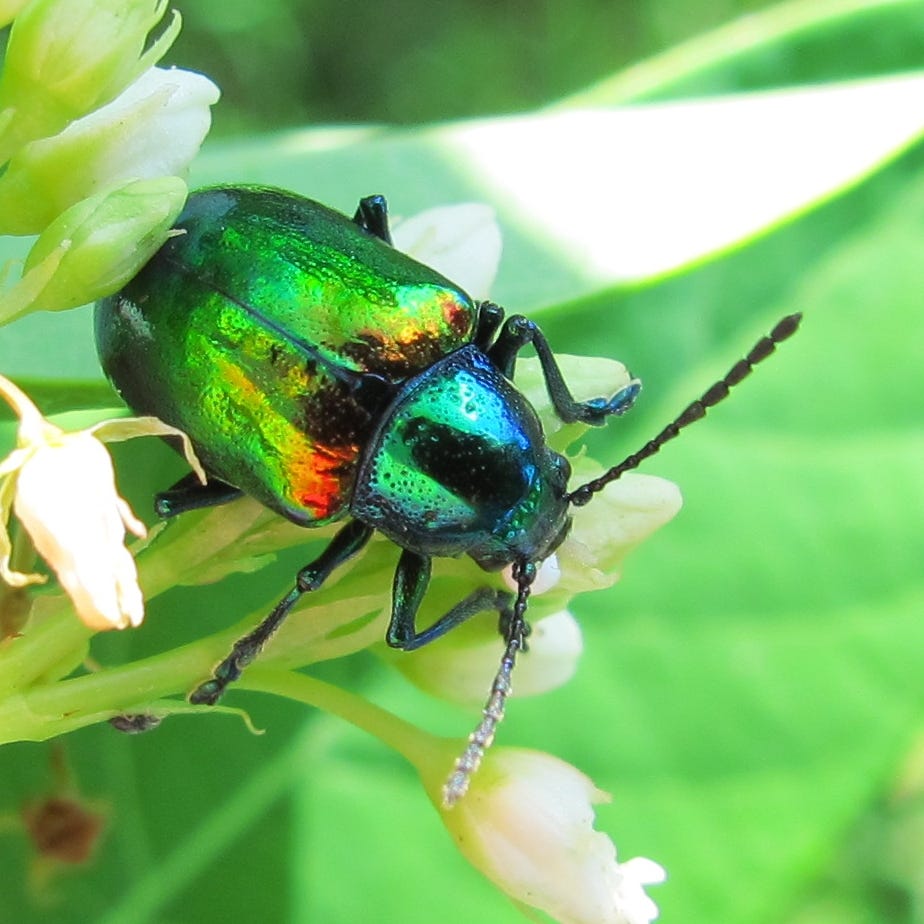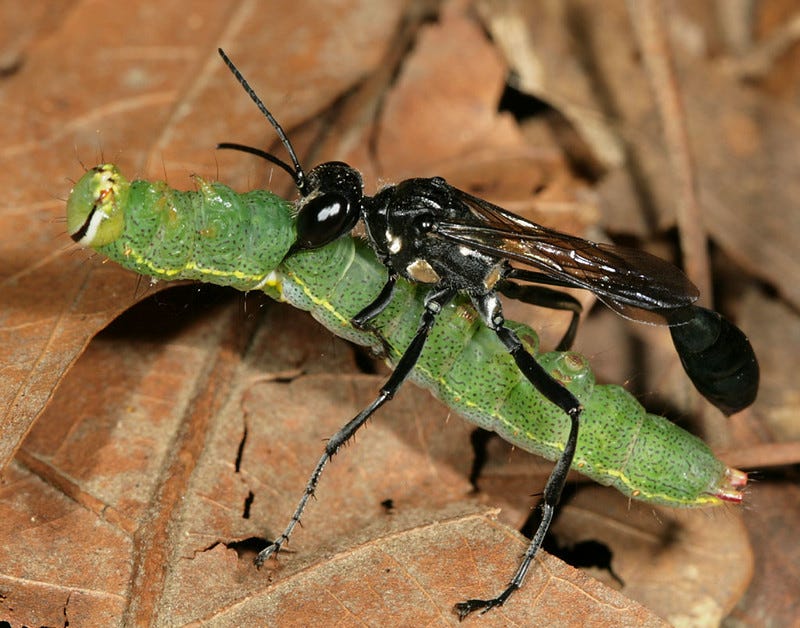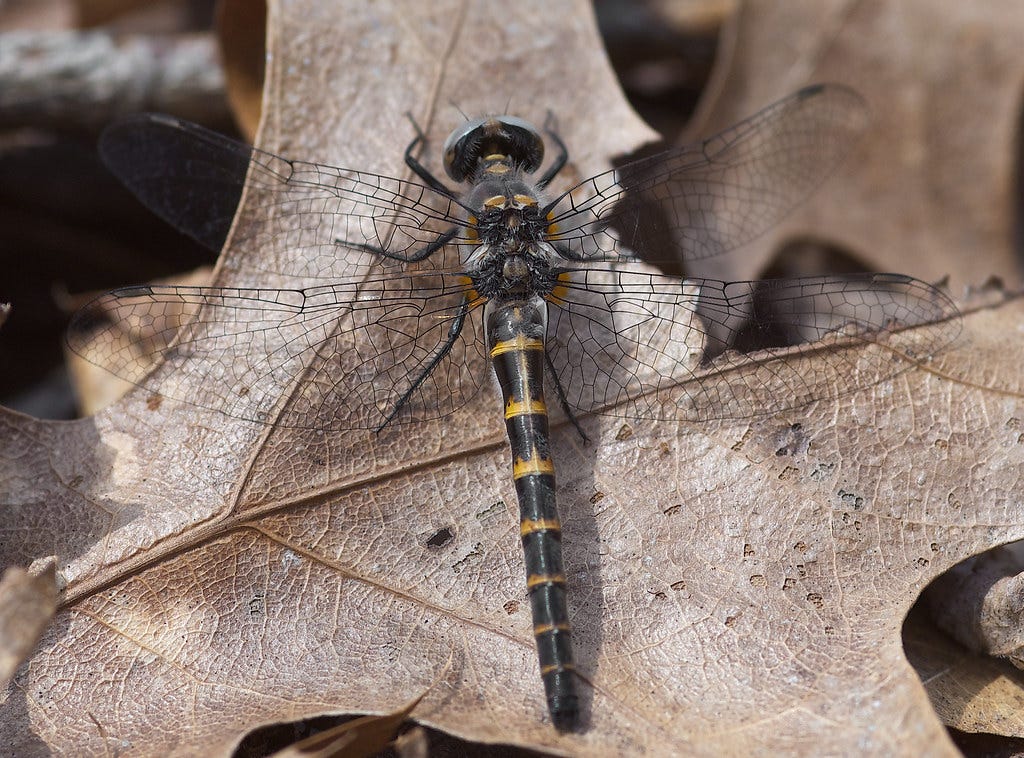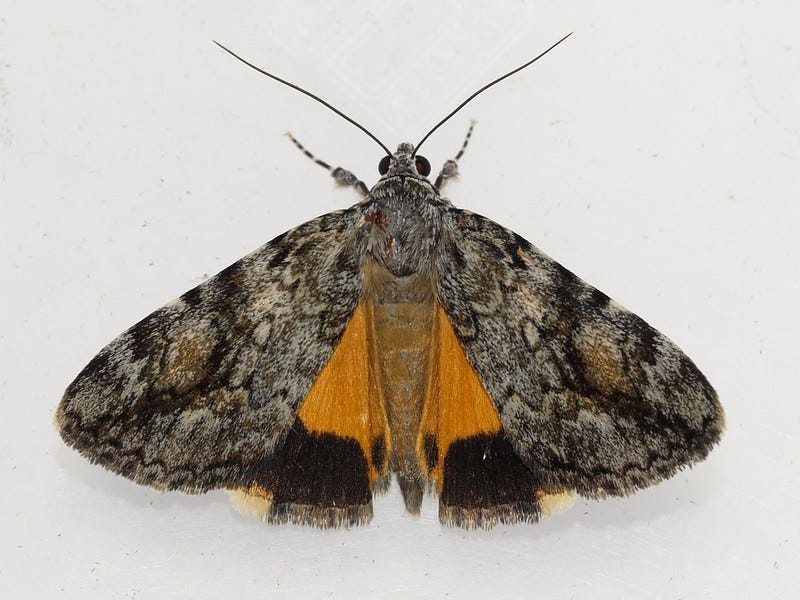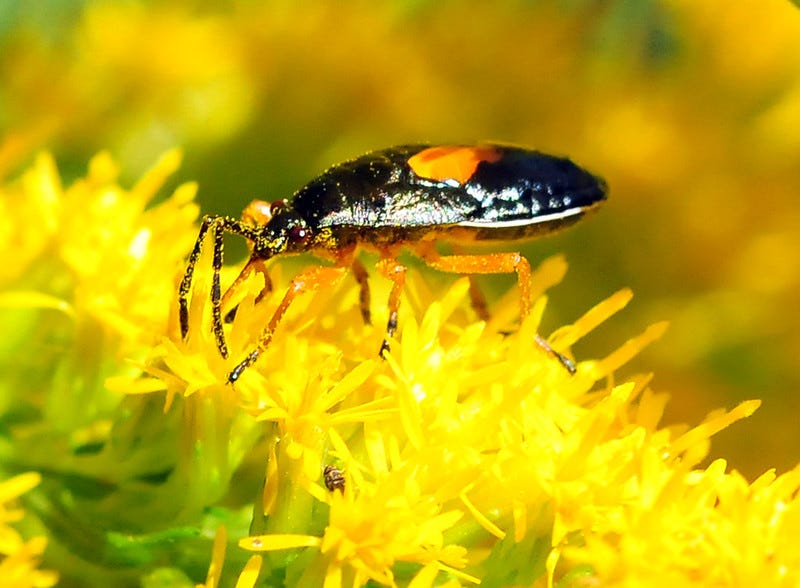The Windshield Phenomenon
11/4/21
Hello everyone:
This week in curated Anthropocene news is focused on climate, given that tens of thousands of government representatives, negotiators, diplomats, NGOs, corporate executives, world leaders, and activists from all the world’s nations are gathering in Glasgow right now for COP26:
COP26 is the 26th U.N. climate change summit (the title is derived from its official name, the Conference of Parties), and its goal is to accelerate progress toward meeting the ambitious 1.5°C goal set at COP21 in Paris. But of course most nations are not on track to meet the promises made in Paris, and even if every nation was on track, it still wouldn’t be enough to limit warming to 1.5°C. The unkept promises were/are insufficient. So those tens of thousands of people have their work cut out for them, especially given that already it looks likely that policy set during this conference will not ensure the Paris goals, but will “keep them alive.”
For a reality check without the diplomacy, here are excerpts from Greta Thunberg’s speech at the Youth4Climate Summit in Italy at the end of September:
Build back better. Blah, blah, blah. Green economy. Blah blah blah. Net zero by 2050. Blah, blah, blah. This is all we hear from our so-called leaders. Words that sound great but so far have led to no action. Our hopes and ambitions drown in their empty words and promises… Over 50% of emissions have occurred since 1990, and a third since 2005… We can no longer let the people in power decide what is politically possible or not. We can no longer let the people in power decide what hope is. Hope is not passive. Hope is not blah, blah, blah. Hope is telling the truth. Hope is taking action. And hope always comes from the people.
For a history of the COP meetings and the slow turning of the civilizational ship toward sorta-kinda-maybe facing up to the climate crisis, check out this infographic from the UK’s Energy and Climate Intelligence Unit.
For a dramatic visual on the frightening realities of warming to 3°C by 2100, here’s a short film from the normally quite unruffled folks at the Economist. (Try not to be distracted by the sideburns.)
And finally, for those of you wanting some excellent climate-focused activist journalism, I recommend Emily Atkin’s very popular Substack newsletter, Heated. Here’s a good sample piece from this summer that makes it clear what the stakes are in this crisis and what you can do to get involved. Read more here to learn about the newsletter and about Emily.
Now on to this week’s essay:
In an odd counterpoint to my concerns about roadkill, I spent much of my time on the road this past summer thinking about the lack of dead insects. Whenever I was out driving I felt like asking other drivers, “Have you noticed that we rarely have to clean dead bugs off of our windshields anymore?” I remember that the windshields of my childhood station wagons and teen junkers were often smeared with the white or yellow spots of insect hemolymph (their blood equivalent), and that our front grills were crusted with their bodies. Dragonfly and damselfly wings stuck out from chrome crevices. For me, this rarely happens anymore.
It turns out that I’m way behind the curve on noticing the lack of dead bugs on my car. It’s been a common gut feeling and a discussion point for over 20 years. It has a name: the Windshield Phenomenon. It sounds like nostalgia – You should have seen the dirty windshields when I was a kid! – but entomologists and ecologists as well as truck drivers and writers like me have the same anecdotal suspicion: there are far fewer bugs turning into mush on our vehicles. Suggestions that today’s more aerodynamic cars are less likely to hit a bug have met with resistance, not least from a UK study that outfitted cars with “splatometers” and found that modern cars caught slightly more bugs than older, chunkier ones. And a German entomologist, Martin Sorg, told Science in 2017: "I drive a Land Rover, with the aerodynamics of a refrigerator, and these days it stays clean.”
I imagine that half the reason my parents bought wiper fluid in the summer was to try to erase, pump after pump, those glue-like spots that blinded us as they caught the afternoon sun. And do you remember how often when you had your hand or arm out the window, riding the slipstream, you’d suddenly feel the sting of a small exoskeleton bullet?
You know where I’m going with this. While we fret about avoiding our own apocalypses, it’s worth wondering if insects are already suffering theirs. The two concerns are not separate, of course, since a) we’re the cause of their decline, and b) insects more or less run the planet. As E.O. Wilson has said, “If all mankind were to disappear, the world would regenerate back to the rich state of equilibrium that existed 10,000 years ago. If insects were to vanish, the environment would collapse into chaos.”
Nearly one million insect species have been identified, but the actual number is estimated to be about 5.5 million, which would mean that insects make up two-thirds of all animal species. There are nearly 1.5 billion insects for every person on Earth, which adds up to a biomass about 70 times greater than that of humans. At a glance, then, Earth would seem to be a planet run by insects with a minority of other species in the fringes.
But this insect dominion, which has held sway for hundreds of millions of years, has become less dominant in the Anthropocene, this new era in which humans are (haphazardly) setting the conditions for life on Earth. And those conditions are declining quickly, in ways that are likely to reduce insect populations: wetlands, grasslands, and forests are disappearing rapidly; monocultural agriculture has spread like wildfire through formerly diverse habitats; pesticide use is rampant and often indiscriminate; invasive species we’ve introduced wreak havoc with native insects and their host plants; and climate change is rapidly unraveling ecosystems in a myriad of unpredictable ways.
Where insects go, we follow. A decline in the complexity of life is inevitably a decline in the quality of human life. Remember that ecosystems are systems rather than objects. They are relationships between species, and between species and environmental conditions. As we impoverish conditions, we impoverish those relationships, which means we impoverish the systems we rely on.
This is the part of the essay where you might expect me to highlight the importance of pollinators for human agriculture, so I will, but please remember that focusing on pollinators is the self-interested equivalent of motivating wealthy Americans to worry about climate change because it might impact their shorefront property values.
Insects are essential for the planet’s food webs, both terrestrial and freshwater aquatic. Sure, they pollinate pretty much everything that flowers (including nearly three quarters of agricultural plants), but they also cycle nutrients, break down decaying matter, disperse seeds, enrich and maintain soil structure, control populations of other organisms, and provide a major food source for much of the world’s animal life.
As the cute bees, moths, and butterflies (and less cute flies, wasps, beetles, mosquitoes, and ants) who make our food and flowers grow, pollinators are also often the only palatable (pun intended) group of insects for the nature-averse residents of a shiny new civilization (that’s us) who no longer see nor understand the value of creatures whose history on Earth stretches back well over 400 million years. We cower when a wasp enters a room and is helplessly looking for a way out. In 2020, we spent 7.36 billion dollars globally on household and garden pesticides. (That’s nearly one dollar for every human on the planet.) One EPA survey found that 75% of U.S. households had used at least one pesticide indoors that year. To be honest, I’m surprised that number isn’t higher.
Most of us know little about insects, other than that some sting, some visit flowers, and some enter our homes and make us uncomfortable. Though I often found them marvelous, beautiful, interesting, or occasionally spooky (Hello, parasitic wasps!) I didn’t pay them close attention until recent years. Now I get a kick every time I open up the field guide Insects of New England and New York to a random page to find the Rosy Maple Moth, the Dogbane Beetle, or the Thread-waisted Wasp. Each is astonishing in its design, and each represents a fragment of a largely unknown world.
We are far more tuned into economies than ecologies, partly because one has literally consumed the other, and partly because we’re distracted social primates who in recent centuries have constructed an unnaturally extractive society that treats other species as fodder rather than as fellow travelers.
Even environmentalists are forced these days, in the uphill battle to protect plants and animals, to discuss them in terms of their “ecosystem services,” a grossly shallow economic term which is both redundant – since without insects, for example, there would be few ecosystems – and a failure of empathy and imagination. We have forgotten what it means to be grateful to the plants, animals, and landscapes that give us life. We’re like burgers who are dismissive of the cow. Our ignorance of the natural world, writes Robin Wall Kimmerer, has consequences:
Ethnobiologists tell us that our great-grandparents spoke fluent natural history. They knew the names and personalities of dozens of birds and hundreds of plants. Today the average American schoolchild can recognize more than a hundred corporate logos. They can give a name to about ten plants, and these include such categories as “Christmas Tree” and “Grass.” We have lost an entire vocabulary, of speech, of experience, and of relationship. Our fundamental currency of relationship, our highly evolved capacity for paying attention to those species who sustain us, has been subverted in a kind of intellectual hijacking. How can we care for them, monitor their well-being, and fight for their existence if we don’t even know their names?
Which brings us to the possibility of an ongoing “insect Armageddon” or “insect apocalypse.” Type those terms into a search bar and a plethora of recent media articles will pop up. A New Yorker article by Elizabeth Kolbert came out just last week with the title “Where Have All the Insects Gone?” which is the same title as a 2017 Science article by Gretchen Vogel. (Both are excellent.) A new book by UK ecologist Dave Goulson, Silent Earth: Averting the Insect Apocalypse, summarizes the evidence and the threats before making an impassioned plea for civilization to remedy the situation.
Discussion in the media – to the extent they’ve paid attention – was sparked in large part by data from the Krefeld Entomological Society, a group of largely amateur German scientists, and by a 2019 paper, “Worldwide decline of the entomofauna: A review of its drivers.” The Science article I note above focuses on the Krefeld story, which amounts to this: insect traps set in more than a hundred nature reserves around Western Europe, where insect populations have been measured by the group for decades, showed that numbers had dropped in numerous locations by 75%. (Also, here’s a great New York Times article on the Krefeld amateurs, among them a schoolteacher, a physicist, an engineer, and some teenagers.)
The “Worldwide decline” paper, billed as a comprehensive review and meta-analysis of global data on insect abundance and diversity over time, offered five key takeaways:
Over 40% of insect species are threatened with extinction.
Lepidoptera [butterflies and moths], Hymenoptera [sawflies, wasps, bees, and ants], and dung beetles (Coleoptera) are the taxa most affected.
Four aquatic taxa are imperiled and have already lost a large proportion of species.
Habitat loss by conversion to intensive agriculture is the main driver of the declines.
Agro-chemical pollutants, invasive species and climate change are additional causes.
But this is where the insect decline narrative hits a speedbump. For a good scientific rebuttal to the idea that windshield observations amounts to evidence, and even that there’s sufficient data to declare that there’s a global insect decline underway, check out these five posts by Australian ecologist Manu Saunders at her blog, Ecology is Not a Dirty Word. Saunders is understandably tough in her assessment of what passes for good science and good scientific conclusions, because to maintain public trust it’s crucial that science remains objective and honest.
In the Insect Apocalypse and Windshield Phenomenon stories, she sees a mess of random observations without consistency or parameters; she sees confirmation bias, since online discussions of bugless windshields generate discussion while contrary observations of heavily splattered windshields are largely ignored; and she sees flaws in studies that cannot properly account for a) insect populations in many regions of the Earth where data simply don’t exist, b) natural changes in insect abundance over long periods, or c) the natural history of the vast majority of insects we know little to nothing about. In other words, generalized observations of the state of global insect populations are nearly impossible to make with confidence, because the data are skimpy across time, space, and number of species.
What we do know, she says, is that while there’s good specific evidence of local or regional declines (as with the Krefeld data), “trends vary widely across taxa and locations.” Some studies have noted increases of certain insect populations, though some of these may be due to our interference, e.g. pesticide use or habitat loss which reduced their insect predators.
Moreover, she says, “focusing on a hyped global apocalypse narrative distracts us from the more important insect conservation issues that we can tackle right now. Promoting this narrative as fact also sends the wrong message about how science works, and could have huge impacts on public understanding of science.” She is particularly critical of the “Worldwide decline” paper, which she found so full of flaws that “it really shouldn’t have been published in its current form…” The key finding of projected extinctions for 40% of insect species she calls “bizarre,” since “we don’t even have population data for 40% of the world’s insect species.” And she notes, despite the paper’s claim to be both a comprehensive review and a meta-analysis, it was neither.
Saunders is in good company. The Entomological Society of America released a statement (pdf download) in response to the media hubbub over the “Worldwide decline” paper that echoed her concerns, noting that extinction predictions “extended well past the limits of the data or have been otherwise over-hyped,” and that good data is particularly absent for “arctic and tropical regions and a majority of the southern hemisphere.” That’s most of the planet.
The ESA and Saunders are both deeply aware of the widespread threats to insects and actively working to understand them. The threats are, of course, likely to be the same threats that are severely reducing populations of mammals, birds, and other charismatic vertebrates. There’s habitat loss, climate change, the overuse of pesticides and other synthetic chemicals, invasive species, light pollution, etc. But they urge that scientific communication about the vitally important story of what’s happening to insects should be based on hard science.
This is tricky, though. Science in general has innumerable data points that describe a planetary habitat overused, upended, poisoned, declining in diversity, and rapidly changing in ways seen only during Earth’s few mass extinctions. The Anthropocene is a term derived from sufficient data to identify an irreversible set of changes made to the community of life by our species. If science doesn’t have clear, robust data to support the Insect Apocalypse story in a vigorous way, doesn’t it have enough information to assume it’s happening? If vast swathes of wetlands and grasslands and forests are disappearing, then aren’t their insect inhabitants disappearing too? Doesn’t a world of clean windshields mean something in the Anthropocene?
Science doesn’t assume, I know, or at least it does so carefully and honestly. Ideally, to understand the state of Earth’s insects, these assumptions would be tested in a global suite of comprehensive studies, each well-funded and run over many years. But we don’t have that kind of time in the 21st century, and most of that funding will not be forthcoming. Much will have to be made of scant data, despite the wishes of good ecologists.
This brings me to one of the questions which haunt this Field Guide. What is the role of science in Anthropocene culture? We love science that enriches our lives but balk at science that challenges our thinking, as the iPhone-carrying anti-mask and anti-vax protestors can attest. We hope science will guide us out of the climate and biodiversity crises but are scarcely invested in making that happen.
I’m struck by the levels of blindness in this insect decline story. Why didn’t I notice the Windshield Phenomenon until now? As a society, we don’t know much about insects because we haven’t invested enough to gain that knowledge. “We have a pretty good track record of ignoring most noncharismatic species,” says entomologist Joe Nocera in the Science article. Entomologists are themselves rare creatures, and growing rarer. We don’t know the insect kingdom that predates and surrounds us, and we don’t know much about how it has changed. But it must be changing, because everything else is.
So how should science talk about it? Should it lean toward the language of activism? Manu Saunders says that a basic principle of science communication is that “Awareness is not the same as engagement or participation… Awareness does not always lead to action, and conservation action that is not evidence-based can do more harm than good,” including eroding public trust in science. Contrast this, though, with Robin Wall Kimmerer’s philosophy that “Attention becomes intention, which coalesces itself to action.” If we attend to this new world and see both the beauty and the harm, we’re empowered to act.
So it will come down to our desire to see the world as it is, and it will come down to our response to what we see. And indeed, all the public noise in response to the flawed “Worldwide decline” report motivated the Entomological Society of America to hold a symposium with the goal to
assemble world experts on insect biodiversity and conservation and ask them to report on the state of knowledge of insect population trends. Speakers were asked to identify major data gaps, call attention to limitations of existing data, and evaluate principal stressors underlying declines, with one goal being to catalyze activities aimed at mitigating well-substantiated declines.
That sounds to me like a classic story of attention becoming action.
Here in our own lives we can take some action too. Work to ban the sale and use of neonicotinoid pesticides wherever you live, at the state and local level. Help preserve large-scale habitats. Clean up freshwater streams and ponds. Encourage farms and public green spaces to reserve diverse habitat for the preservation of a diverse array of insects. Become a devoted amateur entomologist and focus on, say, parasitoid wasps, of which there are merely 650,000 species. Plant pollinator gardens. Turn off outside lights whenever and wherever possible, and advocate for Dark Sky-quality lighting in your community.
That should keep you busy. As a motivator, here are a few more deliciously-named insects from my insect field guide:
The Ringed Boghaunter:
The Girlfriend Underwing:
The Minute Pirate Bug:


